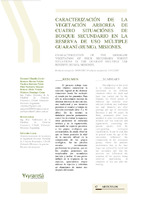Caracterización de la vegetación arbórea de cuatro situaciones de bosque secundario en la Reserva de Uso Múltiple Guaraní (RUMG), Misiones
Characterization of the arborate vegetation of four secondary forest situations in the Guaraní Multiple Use Reserve (RUMG), Misiones
Date
2017-12-01Author
Dummel, Claudio Javier
Romero, Héctor Fabián
Poszkus Borrero, Pablo Andrés
Pahr, Norberto Manuel
Bohren, Alicia Violeta
Maiocco, Domingo César
Rivero, Julian Irineo
Krivenko, Lucas Martín
Metadata
Show full item recordAbstract
El presente trabajo tiene como objetivo caracterizar la sucesión vegetal en las distintas situaciones donde fue realizado el rozado por los guaraníes. Para ello se seleccionaron sectores de distintas historias de uso (sin uso, uso tradicional y uso intensivo posterior al rozado) y tiempo de sucesión (estimado entre 2 y 40 años). En las mismas se instalaron parcelas permanentes con el fin de evaluar la riqueza y otros parámetros de estructura arbórea y de la regeneración, asociando las especies presentes a los grupos ecológicos que corresponden. Se puede observar que en líneas generales la edad de la sucesión influyó en la composición de los grupos ecológicos. En las parcelas rozadas recientemente predominan las pioneras, que en los estadios posteriores son remplazadas por secundarias iniciales y tardías. El uso previo influyó en la respuesta de las especies, apreciándose mayor número de especies y cobertura en situaciones de menor uso después del rozado. The objective of this work is to characterize the plant succession in the different situations where the slash and burn was carried out by the Guarani, for which sectors of different use histories were selected (without use, traditional use and intensive use after grazing) and age of succession (between 2 and 40 years). In them, permanent plots were installed in order to evaluate the richness and tree structure and regeneration, associating the present species with the corresponding ecological classification. It can be seen that in general terms the age of the succession influenced the composition of the ecological groups, where the pioneers predominate that in the later stages are replaced by initial and late secondary and that the previous use influenced the response of the species, being observed appreciating in situations of less use after the burning.
URI
https://hdl.handle.net/20.500.12219/2649http://www.yvyrareta.com.ar/index.php/component/k2/item/69-carac-veg-arborea
Collections
- Revista Yvyraretá [360]
The following license files are associated with this item:




